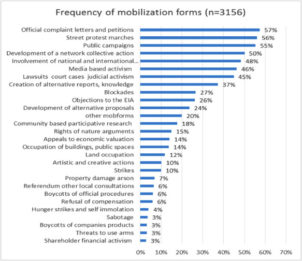
By Joan Martinez-Alier
Abstract
This article describes the origins of the terms “environmental justice” and “environmentalism of the poor and the indigenous” since the 1980s. In 2012 the collection of “ecological distribution conflicts” (EDC) in an Atlas of Environmental Justice (the EJAtlas) started. The EJAtlas reached 3350 entries by January 2021. Such conflicts arise because the industrial economy is not circular, it is entropic. Since the industrial economy is entropic, it continuously looks for new energy and material sources at the “commodity extraction frontiers”, and for waste disposal sites. There are counter-movements of resistance, which become also “valuation system contests” since the participants in such movements (environmental organizations, indigenous peoples, peasants, neighbors and citizens) display different values. Examples recorded in the EJAtlas are given from different continents while answering the questions: Why did the world movement for environmental justice come into being, and which type of social movement is it? The relevance of the EJAtlas for research on comparative, statistical political ecology but also on business economics and management, is noticed.
Keywords
Ecological distribution conflicts; Circular economy; Commodity frontiers; EJAtlas; Environmentalism of the poor; Environmental justice; Valuation contests; Political ecology; Iconography
Link
https://www.sciencedirect.com/science/article/pii/S2214790X21000289#bib0098
How to Cite
Martínez‐Alier, J. (2021). Mapping ecological distribution conflicts: The EJAtlas. The Extractive Industries and Society. https://www.sciencedirect.com/science/article/pii/S2214790X21000289#bib0098

The project ENVJUSTICE has received funding from the European Research Council (ERC) under the European Union’s Horizon 2020 research and innovation programme (grant agreement No. 695446)